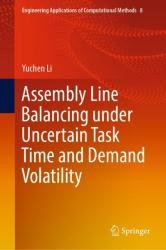Assembly Line Balancing Under Uncertain Task Time and Demand Volatility
- Добавил: literator
- Дата: 14-09-2022, 11:52
- Комментариев: 0
 Название: Assembly Line Balancing Under Uncertain Task Time and Demand Volatility
Название: Assembly Line Balancing Under Uncertain Task Time and Demand VolatilityАвтор: Yuchen Li
Издательство: Springer
Год: 2022
Страниц: 164
Язык: английский
Формат: pdf (true), epub
Размер: 10.2 MB
This book introduces several mathematical models in assembly line balancing based on stochastic programming and develops exact and heuristic methods to solve them. In a manufacturing system, an Assembly Line (AL) is a tool that uses machines to transfer raw materials or parts between workstations. ALs are widely employed to produce various types of products, such as automobiles, electronic equipment, and jewelry. The main components of a standard AL are a conveyor belt, workers, workstations, interchangeable parts, and tasks. The latter are processed by workers at workstations simultaneously. After a period of time (cycle time), parts are moved from one workstation to another. It incorporates two features, uncertain task times, and demand volatility, separately and simultaneously, into the conventional assembly line balancing model. A real-life case study related to the mask production is presented to illustrate the application of the proposed framework and methodology. The book is intended for graduate students who are interested in combinatorial optimizations in manufacturing with uncertain input.
In the 1950s, scientists started to experiment with highly automatic robots in the AL as a means of industrial development. Robots have proved to be faster, more cost effective in high wage countries, and more accurate than humans. From late 20th century to the present, with developments in computer science, the innovation of the AL reaches a whole new level where computer programs and algorithms intelligently automate the production process. It gives birth to some intelligent AL systems, such as assembly lines with supervisory control and learning. The constant research and development (R &D) and ever-changing product market have revolutionary impact on the design and utilization of AL. Today’s AL has been designed to adapt to the mass customization processes with the flexibility of individual preference.
The Chpter 3 employs uncertainty theory to represent uncertain task times and takes into account constraints imposed by incompatible task sets. The problem is solved using a simulated annealing algorithm tailored to the particulars of the problem. To accelerate the simulated annealing algorithm, lower bounds are developed. A restart method is proposed that allows for escape from the local optimum found by neighborhood search. A repair mechanism is added to further increase the quality of solutions by combining the workstations. The numerical examples and practical tests indicate the suggested simulated annealing algorithm’s superior solution-building capacity to teaching-learning-based and genetic algorithms.
Скачать Assembly Line Balancing Under Uncertain Task Time and Demand Volatility
[related-news] [/related-news]
Внимание
Уважаемый посетитель, Вы зашли на сайт как незарегистрированный пользователь.
Мы рекомендуем Вам зарегистрироваться либо войти на сайт под своим именем.
Уважаемый посетитель, Вы зашли на сайт как незарегистрированный пользователь.
Мы рекомендуем Вам зарегистрироваться либо войти на сайт под своим именем.
